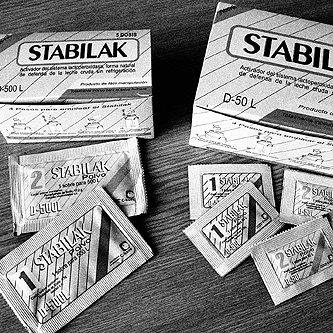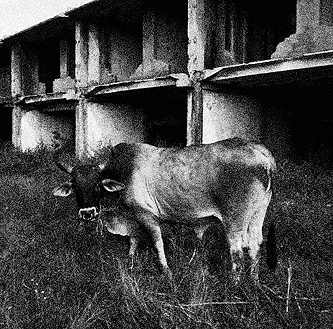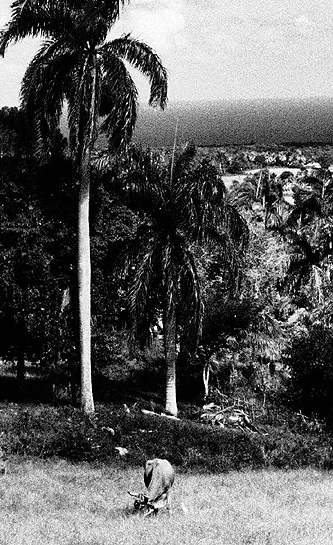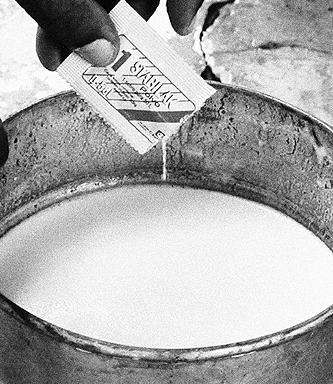Stabilak, for the natural preservation of milk
What problem does it solve?
The situation that inspired research to develop the product was the need to solve problems created by the lack or instability of electricity in some areas of Cuba, which caused losses of milk due to souring. The problem needed a fast, simple and low-cost solution adapted to the characteristics of the sector in question.
The innovation helps confront and solve the following problems in a novel way:
•Large number of dairy herds without refrigeration infrastructure
•Power outages
•Use of inadequate means of transportation, over roads in bad condition and with difficult access
•Long distances between production site and processing centre
•Climate unfavourable for the conservation of the milk’s initial quality
•The use in some countries of substances such as hydrogen peroxide, formol, alcohol, antibiotics and chlorinated products for conserving milk, which leave undesirable residues and are not even allowed for use in milk
Starting during the 1960s in England, research was conducted on the Lactoperoxidase System as an enzyme system present in mammals’ milk. It was the Swedes who, at the end of the 1970s, conducted the first practical experiments to activate the system and achieve an extension in the stability of raw milk.
In 1982, the Joint Committee of FAO-WHO Experts for Milk and Dairy Products, of the Codex Alimentarius, began discussing this activation as an alternative for maintaining milk quality in the absence of refrigeration, without damaging the milk itself, nor harming human health. The favourable conclusions reached on the use of the system led to a long period of research and debates with the highest authorities responsible for food and health. In 1991 use of the system was approved; all that was needed was its practical application. All of the numerous research studies and practical applications performed during the last 12 years have reaffirmed this initial favourable judgement.
In the beginning of the 1980s, studies on the system began in Cuba at the CENSA in order to develop a commercial product capable of achieving the desired results. Regulations established in the Code of Practices of the Codex did not facilitate its use, because they indicate the use of activating substances, a difficult aspect in the daily practice of dairy production. The studies carried out in Cuba contributed an important amount of new knowledge with regard to the level of thiocyanate in milk, and they established median values, extreme thresholds, overdose criteria, physiological factors related to the system, new applications in milk, etc.
In 1988, CENSA devised an activator of the Lactoperoxidase System which came out on the market in a final version under the commercial name of STABILAK. The introduction of this product substituted the practice of using prohibited substances as inhibitors, chemical preservatives, antibiotics, etc., which harmed human health. Since1988 the product has been improving, with focus on the packaging, given the characteristics of one of the components. At present, studies are being conducted to introduce new ways of using it for different quantities of milk, facilitating its function and use, extending its effectiveness – and using the LPS in other liquid products and in solids.
THE PRODUCT ALLOWS FOR:
•Conservation of the initial quality of the milk in dairies without refrigeration facilities
•Conservation of the initial quality of unrefrigerated milk during transport and in industry
•Positive effects on cheese and dairy product production
•Elongation of the conservation time of the milk’s initial quality for system reactivation, using STABILAK 2
•One collection of milk per day, in those areas where two collections were done previously; milking twice daily in those areas without afternoon milk collection
•Conservation of the initial quality of the milk without affecting the organoleptic conditions (odour, flavour, colour) of the milk and without modifying its chemical composition in any way
•Stimulation of the hygienic systems within the milking practices
The use and distribution of the product in Cuba has been carried out in collaboration with these institutions:
•Cuba’s Ministry of Agriculture (field evaluation, approval, as well as widespread use in dairy products)
•Cuba’s Ministry of Food Industries (evaluation of milk collection, effects on dairy products, control of widespread use and approval)
•Cuba’s Ministry of Public Health (approval of the registry and advising on the technological components of manufacturing the finished product)
•Ministry of Science, Technology and Environment (research project funding)
•The FAO (support for validation and distribution of the product through the GLP)
The following trials were carried out to evaluate STABILAK’s capability:
•Laboratory studies to learn the effect on some indicators of the deterioration of milk over time, such as acidity and its composition as a function of the temperature and initial quality of the milk
•STABILAK’s effect on the growth over time of different groups of micro-organisms present in milk
•Bacteriostatic capacity against pathogenic microorganisms in previously contaminated milk
•Numerous studies on the presence of thiocyanate in milk and other trials for increasing the toxicological criteria and security of the product; relation between the LPS’s characteristics and the physiological condition of the producing cow
•Trials for evaluating the effect of reactivation of the method, once activated a first time
•Evaluation of the effect of the technological processes on quality of the final dairy products
•Study of system’s effect on goat and buffalo milk, on the milk of different bovine species, on refrigerated milk, on milk prior to pasteurisation, on time elapsed from milking to activation
In the milking barns and industries the following tests were performed:
•The ability to conserve the milk’s initial quality in dairies with no refrigeration facilities.
•Quality controls on milk not refrigerated during transport and in industry.
•STABILAK’s effect on the manufacture of cheeses and products made from milk.
•Prolongation of the conservation time of the milk’s initial quality, through reactivation of the system using STABILAK 2.
•Test of expansion of the field – use of the commercial form of STABILAK in field conditions. Taken into account was its effectiveness in production conditions to be used simultaneously on seven dairy farms in Havana province, covering more than five million litres of treated milk that would have gone to waste without treatment.
•In Cuba in recent years more than 600 million litres of raw milk have been treated with excellent results and with no harm to human health being reported. Annually between 60 and 80 million litres of milk are protected with STABILAK; this represents a savings of the equivalent of approximately 30 000 metric tonnes of milk powder that would have had to be imported had the milk gone sour due to lack of refrigeration.
•In Havana Province there is a Centre of Goat Milk Production for children with an intolerance to cow milk. That milk, along with buffalo milk, has been treated with STABILAK.
•Cuba’s Agricultural Ministry assigns an annual budget for manufacture of the product destined for businesses in the country.
•There are multiple applications in more than 20 countries with emphasis on the tropical regions.
In relation to the final production, the aspects evaluated have been: active PRINCIPIOS; uniformity of doses; hermeticity; weight, hardness; organoleptic properties; evaluation of the biological activity.
Experiments as well as practice have shown the effect of activation of the Lactoperoxidase System, the possibility of reactivation lengthening the time of its effect, and characteristics of its components in the tropics. A commercial product was devised which allowed for quick, simple and economic use that does not affect the producing of dairy products and does not harm human health. Valuable experience was obtained during its extensive use over more than a decade and a control system was established. Many beneficial criteria for use in other countries were established. Ample recognition at the national and international levels was received, which culminated in having won the Gold Medal of the World Organization for Intellectual Property.








 COUNTRY OF ORIGIN
COUNTRY OF ORIGIN OUTSTANDING IDEASS PROJECTS
OUTSTANDING IDEASS PROJECTS